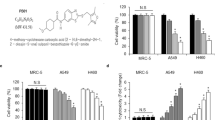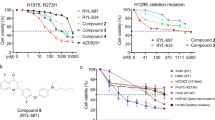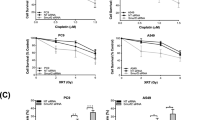Abstract
Lung cancer is difficult to control locally by radiotherapy and is known to have frequently p53 mutations. Previous results have shown that non-small-cell lung cancer (NSCLC) cell lines with nonfunctional p53 have a higher fraction of radiation-induced apoptosis and that apoptosis follows after the release from the G2/M arrest. The aim of the present work was to study whether inhibition of the p53 response in NSCLC cell lines can modulate the G2/M arrest and the induction of apoptosis after ionizing radiation. Antisense oligodeoxynucleotides (As-ODNs) were used to inhibit the p53 response in the cell lines H460 and A549 with functional p53. In addition, H661 with nonfunctional p53 was used. The results have shown that As-ODNs targeting mRNA of p53 and p21 downregulate radiation-induced expression of p53 and p21WAF1/CIP1. Delayed apoptosis (35.7±4.2% in H460, 1.2±0.4% in A549 and 72.2±6.5% in H661) was observed after cell cycle progression beyond the G2 block, either in the late G2 phase of the same cell cycle being irradiated (H661) or in the G1 phase of the subsequent cell cycle (H460, A549). As-p53 significantly decreased the fraction of G2/M-arrested cells in H460 cells and increased radiation-induced apoptosis at 96 hours by 17.9±8.5 and 9.1±3.3% to 53.6±7.4 and 10.8±2.9% in H460 and A549 cells (P<.01), respectively, but had no effect in H661 cells with nonfunctional p53. In addition, As-p21 decreased the fraction of G2-arrested A549 and H460 cells and increased apoptosis by 23.8±5.2 and 31.6±7.3% to 59.4±3.1 and 32.8±7.3%, respectively (P<.01). In conclusion, these data show that radiation-induced G2 arrest is decreased in NSCLC cells and radiation-induced apoptosis is increased when p53-responsive pathways are blocked via As-ODN targeting p53 or p21WAF1/CIP1 mRNA. In view of the fact that p53 and p21 As-ODN had similar effects on radiation-induced apoptosis normalized by their ability to inhibit radiation-induced p21 expression, we concluded that p21 is an important trigger of late ionizing radiation-induced apoptosis.
This is a preview of subscription content, access via your institution
Access options
Subscribe to this journal
Receive 12 print issues and online access
$259.00 per year
only $21.58 per issue
Buy this article
- Purchase on Springer Link
- Instant access to full article PDF
Prices may be subject to local taxes which are calculated during checkout







Similar content being viewed by others
References
Greenblatt MS, Bennett WP, Hollstein M, Harris CC . Mutations in the p53 tumour suppressor gene: clues to cancer etiology and molecular pathogenesis. Cancer Res. 1994;54:4855–4878.
Brugarolas J, Chandrasekaran C, Gordon JI, Beach D, Jacks T, Hannon GJ . Radiation-induced cell cycle arrest compromised by p21 deficiency. Nature. 1995;377:552–557.
Waldman T, Kinzler KW, Vogelstein B . p21 is necessary for the p53-mediated G1 arrest in human cancer cells. Cancer Res. 1995;55:5187–5190.
Stewart N, Hicks GG, Paraskevas F, Mowat M . Evidence for a second cell cycle block at G2/M by p53. Oncogene. 1995;10:109–115.
Agarwal ML, Agarwal A, Taylor WR, Stark GR . p53 controls both the G2/M and the G1 cell cycle checkpoints and mediates reversible growth arrest in human fibroblasts. Proc Natl Acad Sci USA. 1995;92:8493–8497.
Schwartz D, Almog N, Peled A, Goldfinger N, Rotter V . Role of wild type p53 in the G2 phase: regulation of the γ-irradiation-induced delay and DNA repair. Oncogene. 1997;15:2597–2607.
Winters ZE, Ongkeko WM, Harris AL, Norbury CJ . p53 regulates Cdc2 independently of inhibitory phosphorylation to reinforce radiation-induced G2 arrest in human cells. Oncogene. 1998;17:673–684.
Stuschke M, Sak A, Wurm R, et al. Radiation induced apoptosis in human non-small-cell lung cancer cell lines is secondary to cell-cycle progression beyond the G2-phase checkpoint. Int J Radiat Biol. 2002;78:807–819.
Jin P, Gu Y, Morgan DO . Role of inhibitory CDC2 phosphorylation in radiation-induced G2 arrest in human cells. J Cell Biol. 1996;134:963–970.
Blasina A, Paegle ES, McGowan CH . The role of inhibitory phosphorylation of CDC2 following DNA replication block and radiation-induced damage in human cells. Mol Biol Cell. 1997;8:1013–1023.
Jin P, Hardy S, Morgan DO . Nuclear localisation of cyclin B1 controls mitotic entry after DNA damage. J Cell Biol. 1998;141:875–885.
Chan TA, Hermeking H, Lengauer C, Kinzler KW, Vogelstein B . 14-3-3σ is required to prevent mitotic catastrophe after DNA damage. Nature. 1999;401:616–620.
Bunz F, Dutriaux A, Lengauer C, et al. Requirement for p53 and p21 to sustain G2 arrest after DNA damage. Science. 1998;282:1497–1501.
Wang XW, Zhan Q, Coursen JD, et al. GADD45 induction of a G2/M cell cycle checkpoint. Proc Natl Acad Sci USA. 1999;96:3706–3711.
Chang BD, Watanabe K, Broude EV, et al. Effect of p21Waf1/Cip1/Sdi1 on cellular gene expression: implications for carcinogenesis, senescence, and age-related diseases. Proc Natl Acad Sci USA. 2000;97:4291–4296.
Chang WP, Little JB . Persistently elevated frequency of spontaneous mutations in progeny of CHO clones surviving X-irradiation: association with delayed reproductive death phenotype. Mutat Res. 1992;270:191–199.
Vidair CA, Chen CH, Ling CC, Dewey WC . Apoptosis induced by X-irradiation of rec-myc cells is postmitotic and not predicted by the time after irradiation or behaviour of sister cells. Cancer Res. 1996;56:4116–4418.
Lowe SW, Schmitt EM, Smith SW, Osborne BA, Jacks T . p53 is required for radiation-induced apoptosis in mouse thymocyetes. Nature. 1993;362:847–849.
Slichenmyer WJ, Nelson WG, Slebos RJ, Kastan MB . Loss of a p53-associated G1 checkpoint does not decrease cell survival following DNA damage. Cancer Res. 1993;53:4164–4168.
Brachman DG, Beckett M, Graves D, Haraf D, Vokes E, Weichselbaum RR . p53 mutation does not correlate with radiosensitivity in 24 head and neck cancer cell lines. Cancer Res. 1993;53:3667–3669.
Strasser A, Harris AW, Jacks T, Cory S . DNA damage can induce apoptosis in proliferating lymphoid cells via p53-independent mechanisms inhibitable by Bcl-2. Cell. 1994;79:329–339.
Merrit AJ, Allen TD, Potten CS, Hickman JA . Apoptosis in small intestinal epithelia from p53-null mice: evidence for a delayed, p53-independent G2/M-associated cell death after γ-irradiation. Oncogene. 1997;14:2759–2766.
Lanza F, Bi S, Moretti S, Castoldi G, Goldman JM . Modulation of cell kinetics and cell cycle status by treating CD34+ chronic myeloid leukaemia cells with p53 antisense phosphorothioate oligonucleotides. Br J Haematol. 1995;90:8–14.
Iotsova V, Stehelin D . Antisense p53 provokes changes in HeLa cell growth and morphology. Eur J Cell Biol. 1995;68:122–132.
Bellido T, O'Brien CA, Roberson PK, Manolagas SC . Transcriptional activation of the p21(WAF1,CIP1,SDI1) gene by interleukin-6 type cytokines. A prerequisite for their pro-differentiating and anti-apoptotic effects on human osteoblastic cells. J Biol Chem. 1998;273:21137–21144.
Burgess TL, Fisher EF, Ross SL, et al. The antiproliferative activity of c-myb and c-myc antisense oligonucleotides in smooth muscle cells is caused by a nonantisense mechanism. Proc Natl Acad Sci USA. 1995;92:4051–4055.
Sak A, Stuschke M, Wurm R, et al. Selective inactivation of DNA-PKcs with antisense oligodeoxynucleotides: consequences for the rejoining of radiation induced DNA double-strand breaks and radiosensitivity of human cancer cell lines. Cancer Res. 2002;62:6621–6624.
Gilligan D, Mort C, McMillan TJ, Peacock JH, Titley J, Ormerod MG . Application of a bromodeoxyuridine-Hoechst/ethidium bromide technique for the analysis of radiation-induced cell-cycle delays in asynchronous cell populations. Int J Radiat Biol. 1996;69:251–257.
Tishler RB, Calderwood CN, Coleman CN, Price BD . Increases in specific DNA binding by p53 following treatment with chemotherapeutic and DNA damaging agents. Cancer Res. 1993;53:2212–2216.
Palayoor ST, Macklis RM, Bump EA, Coleman CN . Modulation of radiation-induced apoptosis and G2/M block in murine T-lymphoma cells. Radiat Res. 1995;141:235–243.
Bracey TS, Williams AC, Paraskeva C . Inhibition of radiation induced G2 delay potentiates cell death by apoptosis and/or induction of giant cells in colorectal tumor cells with disrupted p53 function. Clin Cancer Res. 1997;3:1371–1381.
Passalaris TM, Benanti JA, Gewin L, Kiyono T, Galloway DA . The G(2) checkpoint is maintained by redundant pathways. Mol Cell Biol. 1999;19:5872–5881.
Xiong Y, Hannon GJ, Zhang H, Casso D, Kobayashi R, Beach D . p21 is a universal inhibitor of cyclin kinases. Nature. 1993;366:701–704.
Tian H, Wittmack EK, Jorgensen TJ . p21WAF1/CIP1 antisense therapy radiosensitizes human colon cancer by converting growth arrest to apoptosis. Cancer Res. 2000;60:679–684.
Poluha W, Poluha DK, Chang B, et al. The cyclin-dependent kinase inhibitor p21 (WAF1) is required for survival of differentiating neuroblastoma cells. Mol Cell Biol. 1996;16:1335–1341.
Matsuoka S, Huang M, Elledge SJ . Linkage of ATM to the cell cycle regulation by the Chk2 protein kinase. Science. 1998;282:1893–1897.
Miyashita T, Krajewski S, Krajewski M, et al. Tumor suppressor p53 is a regulator of bcl-2 and bax gene expression in vitro and in vivo. Oncogene. 1994;9:1799–1805.
Strasser-Wozak EM, Hartmann BL, Geley S, et al. Irradiation induces G2/M cell cycle arrest and apoptosis in p53-deficient lymphoblastic leukemia cells without affecting Bcl2 and bax expression. Cell Death Differ. 1998;5:687–693.
Bracey TS, Miller JC, Preece A, Paraskeva C . Radiation-induced apoptosis in human colorectal adenoma and carcinoma cell lines can occur in the absence of wild-type p53. Oncogene. 1995;10:2391–2396.
Uberti D, Schwartz D, Almog N, et al. Epithelial cells of different organs exhibit distinct patterns of p53-dependent and p53-independent apoptosis following DNA insult. Exp Cell Res. 1999;252:123–133.
Patel V, Ensley JF, Gutkind JS, Yeudall WA . Induction of apoptosis in head-and-neck squamous carcinoma cells by γ-irradiation and bleomycin is p53-independent. Int J Cancer. 2000;88:737–743.
Burger H, Nooter K, Boersma AWM, Kortland CJ, van den Berg AP, Stoter G . Expression of p53, p21/WAF/CIP, Bcl-2, Bcl-X, and Bak in radiation-induced apoptosis in testicular germ cell tumor lines. Int J Radiat Oncol Biol Phys. 1998;41:415–424.
Cross SM, Sanchez CA, Morgan CA, et al. A p53-dependent mouse spindle checkpoint. Science. 1995;267:1353–1356.
Fukasawa K, Choi T, Kuriyama R, Rulong S, Vande Woude GF . Abnormal centrosome amplification in the absence of p53. Science. 1996;271:1744–1747.
Acknowledgements
This research was supported by grants from the Deutsche Forschungsgemeinschaft (Stu 151/4-4) and from the Deutsche Krebshilfe (10-1389).
Author information
Authors and Affiliations
Corresponding author
Rights and permissions
About this article
Cite this article
Sak, A., Wurm, R., Elo, B. et al. Increased radiation-induced apoptosis and altered cell cycle progression of human lung cancer cell lines by antisense oligodeoxynucleotides targeting p53 and p21WAF1/CIP1. Cancer Gene Ther 10, 926–934 (2003). https://doi.org/10.1038/sj.cgt.7700649
Received:
Published:
Issue Date:
DOI: https://doi.org/10.1038/sj.cgt.7700649
Keywords
This article is cited by
-
Vicenin-2: a potential radiosensitizer of non-small cell lung cancer cells
Molecular Biology Reports (2018)
-
Responses of Solid Tumor Cells in DMEM to Reactive Oxygen Species Generated by Non-Thermal Plasma and Chemically Induced ROS Systems
Scientific Reports (2015)
-
Regulating apoptosis in mammalian cell cultures
Cytotechnology (2006)
-
Targeting of Rad51-dependent homologous recombination: implications for the radiation sensitivity of human lung cancer cell lines
British Journal of Cancer (2005)
-
Down-regulation of p21 contributes to apoptosis induced by HPV E6 in human mammary epithelial cells
Apoptosis (2005)



